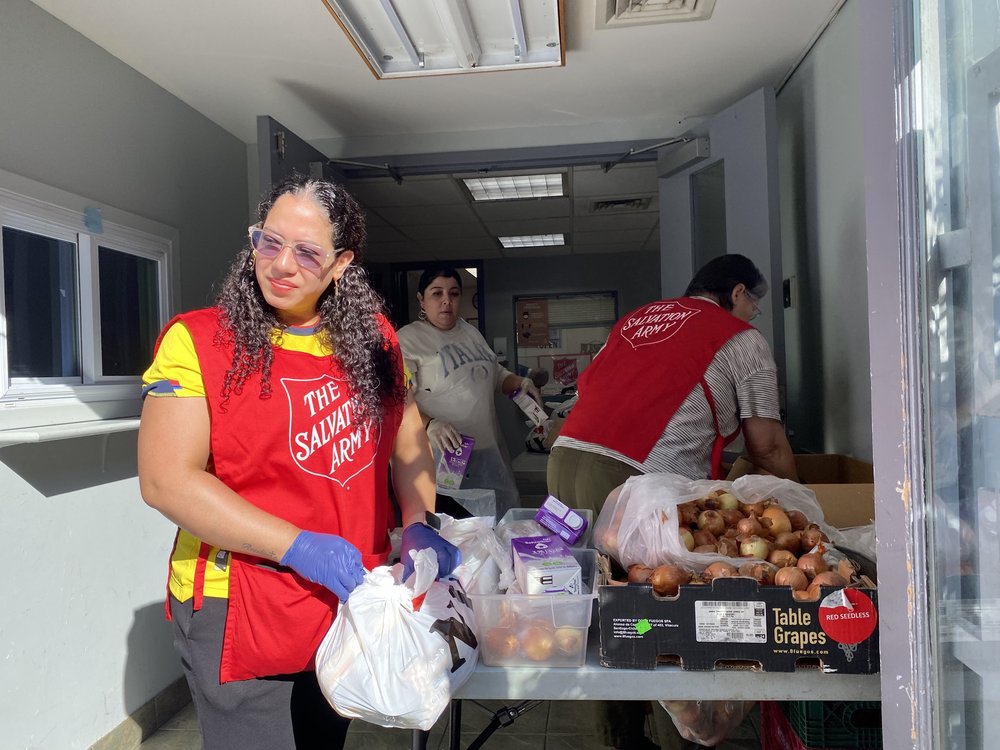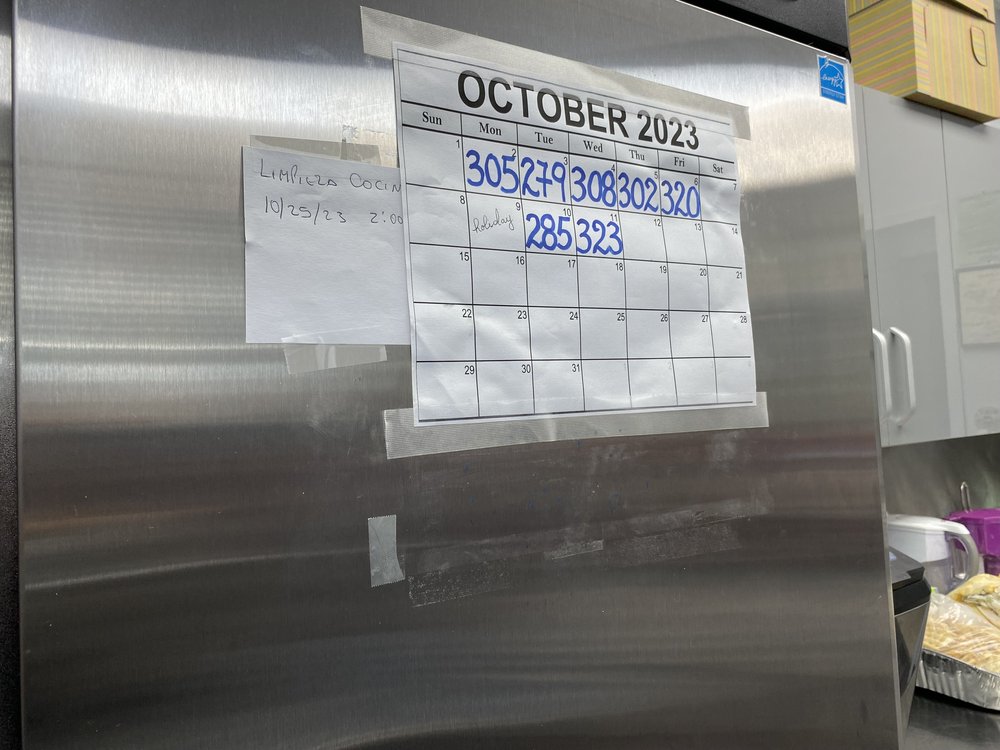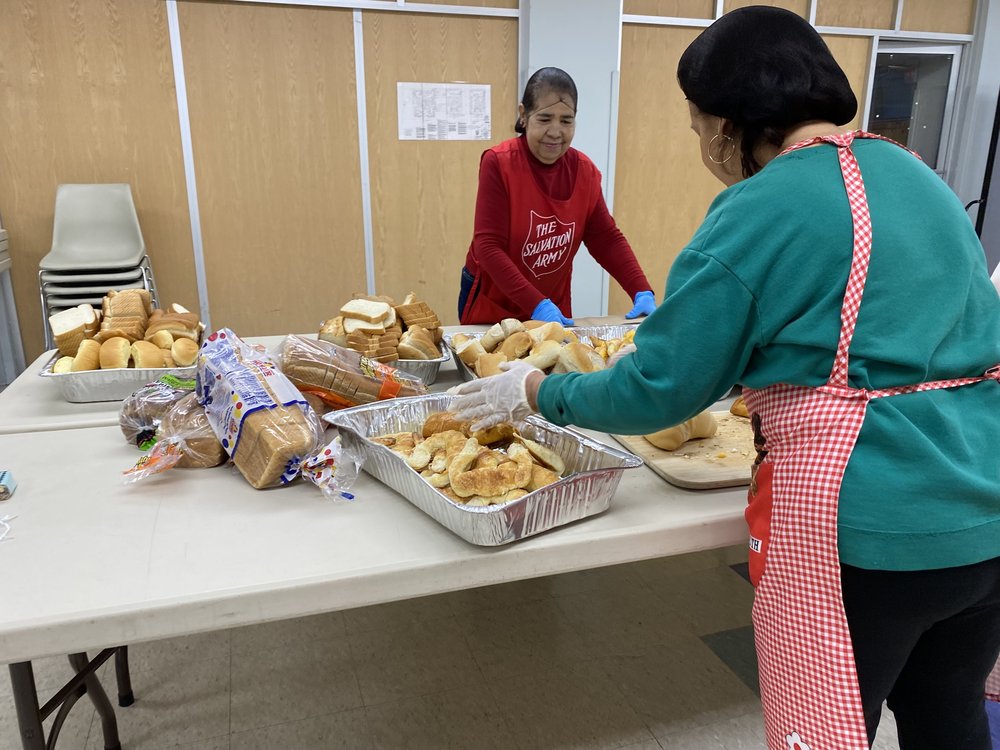Food pantry visits surge in NYC as 'perfect storm' over benefit delays and inflation aligns
Oct. 13, 2023, 5:01 a.m.
Food pantries across New York City are reporting a spike in demand, a reminder of the early days of the pandemic.

Lines for hot meals and free groceries are growing longer, New York City nonprofits say, citing a surge in recent months reminiscent of the worst days of the pandemic when crowds wrapped around the block.
The Salvation Army says they’ve served 53% more meals to New Yorkers in the first nine months of 2023, compared to the same time the year prior. Meanwhile, the Food Bank for New York City is seeing an 8% uptick in average monthly visits since February.
Food pantry providers point to the end of a pandemic-spurred food assistance benefit that gave people extra cash to buy groceries, a record backlog at a city agency delaying public assistance checks and skyrocketing food prices for the growing demand.
“When the SNAP benefit is less or is delayed, then you start to really have problems on top of existing problems,” said Stephen Grimaldi, executive director of the New York Common Pantry. He said they served 30% more hot meals in fiscal year 2023 than the year before.
City data shows more than half the applications for cash assistance and Supplemental Nutrition Assistance Program benefits, known as SNAP, weren’t processed on time between last July through June of this year, the worst rates reported in at least 10 years, Gothamist previously reported. The city’s Department of Social Services previously said they’re working to reduce delays but are facing an unprecedented number of applications amid staff attrition.
A monthly look at the numbers show just 10.7% of the 43,000 cash assistance applications in June were processed on time, according to city data. That’s the lowest rate since 2006. About 30% of cash assistance applications and about 40% of food stamp applications were processed within 30 days as required by state and federal laws.
A Department of Social Services spokesperson didn’t immediately respond to questions. But agency officials previously told Gothamist the need among New Yorkers hasn’t abated since the start of the COVID-19 pandemic. The agency said it receives an average of 40,000 cash assistance and 40,000 SNAP applications a month, nearly double pre-pandemic levels.
“It's absolutely unacceptable that the processing rates are lower than they've been under a number of previous mayors,” said Joel Berg, CEO of Hunger Free America. “Food pantries and in some cases soup kitchens are even more overwhelmed.”
‘The perfect storm’
On Thursday, about 200 people lined up outside the Salvation Army Queens Temple Corps in Jackson Heights as volunteers handed out onions, beans, raisins, tuna and milk starting at 10 a.m.
But some residents lined up as early as 6 a.m.
“It reminds us of the pandemic,” Major Guillermo Di Caterina, who directs the Queens facility, said as he walked down the line on 35th Avenue that curled around 86th street.
Di Caterina said he thought demand would let up after the pandemic, but the extra $95 a month in food stamp benefits from the federal government that ended in February, along with rising food costs is exacerbating the demand.

The longer lines and growing demand also comes as food prices rose 3.6% in September in the New York region, compared to the year prior, according to data released Thursday by the Bureau of Labor Statistics.
“It's like the perfect storm,” Di Caterina said, noting the need is widespread among people who lost their jobs, new migrant arrivals, seniors on fixed income and residents who can’t get public assistance or can’t stretch those dollars to the end of the month.
“Before COVID, we will serve 90% of Hispanic families. Right now, you can see the diversity. We have Asians, we have people from India, Bangladesh, South America, Central America,” he said.
Juana Reyes, 56, said her daughter who used to live with her previously received SNAP benefits. She said the supplemental money would help them get through the month.
“That little bit of food you buy at the grocery store, it was something for a gallon of milk or some fruit,” she said in Spanish, as she waited outside the food pantry around 8 a.m.
No safety net
The Adams’ administration’s abysmal delays in approving public assistance within 30 days means residents have to find emergency food options – and that’s squeezing food pantries and soup kitchens, advocates say.
“Delays in processing cause catastrophic results because they don't have an option that fills in the gap while these things are processing,” said Whitney Coulson, a program director at Henry Street Settlement, a social service provider in the Lower East Side. The agency runs a small food pantry through its mental health program that normally serves 250 residents and now serves another 100.
“At the end of the day, these are people who literally have no safety net. This is supposed to be their safety net,” Coulson said.

Nonprofit groups who also help residents apply for benefits say their clients are often waiting up to four hours on the phone for the required interview to secure benefits.
Department of Social Services officials said during a City Council committee hearing last month that they changed the process to allow applicants to call the agency for their interview to give them flexibility to ring when they’re free.
“But when you call, you can't get a hold of anyone,” said Muhammad Al-Amin, managing director of programs at New York Common Pantry.
Department of Social Services representatives also said as of Aug. 31, about 30,000 households were waiting more than a month to receive cash assistance or SNAP benefits. Of those, 4,000 were waiting more than two months and 300 were delayed by more than 90 days, according to additional numbers provided by the Legal Aid Society.
Zac Hall, senior vice president of programs at the Food Bank for New York City, said a lag in benefits can mean families are having to make different decisions about their health.
“Oftentimes folks will make decisions about consuming less nutritious calorie dense foods because they're cheaper. And that can drive epidemics of obesity and disease,” he said. “Think about seniors in their households who are making decisions on fixed income about what they can do with their money and maybe foregoing medications, maybe foregoing healthcare visits.”
NYC rate of processing food stamp, cash assistance applications hits record lows As grocery prices climb, millions of New Yorkers brace for the end of pandemic-era food stamps